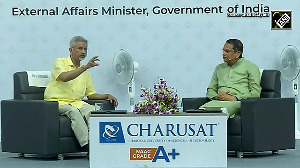What funds must I invest in for retirement planning? What funds are ideal for my children's education planning?
Mutual funds are the ideal investment option for funding retirement and children's education. However, they must form only a part of such portfolios. Here's why. Capital protection is one of the foremost requirements of a retirement or education fund. And there is not a single mutual fund that carries a capital guarantee on your principal amount. For this reason, you cannot afford to ignore instruments such as the Public Provident Fund (PPF), National Savings Certificate (NSC) and the likes. While these instruments offer a decent risk-free return on investment, they may not suffice for your post retirement or children's education planning needs.
For this reason you could look at equity-oriented mutual funds to boost returns. But when considering equity instruments, take cognizance of one's time horizon of investment. The longer you can stay invested, the more equity allocation you can afford. Hence, if you are 27 years old and plan to retire at 60, you can invest the bulk of your portfolio in equity oriented schemes. This is true for planning children's education as well. If your child is 16 years old and you need the money in two years, you should completely avoid equity funds.
As you near your goal, you ought to start redeeming your equity investments and re-invest these in safer debt-oriented instruments. Hence when you are about 56-58 years old, you can institute a systematic withdrawal plan and reinvest the money in safer instruments.
The category of balanced funds is especially useful for such life stage planning. These funds invest at least 65 per cent of the corpus in equity and the rest is in debt instruments. When the equity segment of the fund does exceedingly well, the fund rebalances the portfolio, booking profits in equity and transferring to debt. This way, your risk exposure is kept in check.
I want to make an additional investment. Which are the new and good funds that I ought to invest in?
This one is really tricky, especially when we have no clue about the investor's portfolio. When making such a decision, take a good look at where you stand. As a first step you can use the portfolio tool on our website.
The first investment decision must be based on your asset allocation i.e how much of your money is invested in equity and debt instruments. Then you ought to look at the allocation and weightage to various funds and fund houses. In case you are overweight on a particular fund or fund house, avoid these funds. In case you are underweight on a well-performing fund, then channelise your investments to such a fund.
Assess your exposure to large-cap and mid-cap stocks. Accordingly pick a fund that will equate any such deficiency. Though these are basic steps, more often than not such a short exercise will help you plan your additional investments.
Before you consider adding more funds to your portfolio, look at current holdings and try to work with them.
One is advised to look at the offer document before investing. To me, all offer documents look similar. What should I look out for?
The offer document is an essential read before investing. In fact, all mutual fund distributors and financial planners are required to give their clients a copy of the same before the investor signs the application form.
Since these documents tend to be exceedingly lengthy and almost identical, you should at least go through the Key Information Memorandum (KIM) of the fund.
Here are some key factors that you need to keep an eye out for.
Investment Objective: This will explain the mandate and scope of investment. Whether the fund is equity or debt oriented, whether the fund will be multi-, large, mid- or small-cap specific, the level of diversification, the option to the fund manager to invest overseas and other such issues.
Type of fund: Is the fund open- or close-ended? In case of a close-end fund, look at the lock-in period, liquidity window and repurchase options.
Costs: Fees, expenses and loads are other big items to look out for.
Investment: Minimum initial investment, methods of purchasing, redeeming and making additional investments, the time taken for redemption, so forth and so on.
Fund Manager: Number of fund managers managing the fund and information on each. This information is useful to those who would like to check the antecedents of the manager. Most of this information is available in the KIM as well, but if you can spare the time, give a good look to the offer document as well.
How must I decide whether to hold on or to exit a fund?
If we had a rupee for every time we came across such a question! But this one has an easy solution. Ask yourself why you want to redeem your investment. If you need the money, go ahead. Are you apprehensive of the fund's performance? In that case, check out how the fund has done over the past three years.
Look at the year-to-date performance of the fund vis-à-vis its peer group. If we are only a quarter or so into the year then look at the one-year return as against the category. Also look at the performance over the past four quarters. This will clearly specify whether the fund has been a consistent performer over the past year or just has an odd good quarter.
Apart from this you could also look at how the fund fits in with the rest of your holdings. In case it is a theme-based fund, see if the theme still has any steam left in it. If you have other funds with a similar investment objective, pick the better performer.







 © 2025
© 2025